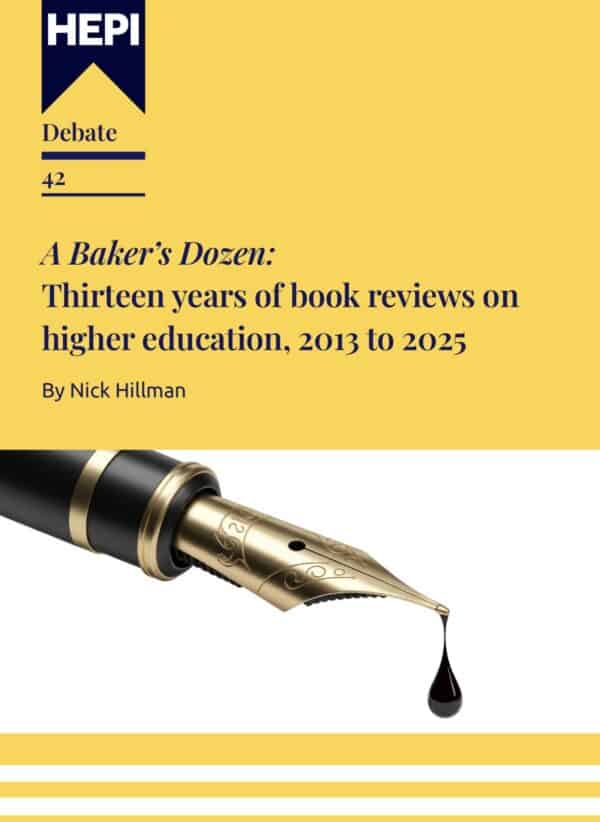Weekend Reading: Provoking changes in higher education, some reflections on governance
- This HEPI guest blog was kindly authored by Professor Nigel Savage. Nigel was awarded his PhD in 1980 for research into corporate governance and held several chief executive and non-executive posts in the public and private sectors, including Board membership of HEFCE and non-executive director of Fletchers solicitors.
- On Tuesday, HEPI and Cambridge University Press & Assessment will be hosting the UK launch of the OECD’s Education at a Glance. On Wednesday, we will be hosting a webinar on students’ cost of living with TechnologyOne – for more information on booking a free place, see here.
Universities are facing the ‘perfect storm’ of challenges from several areas, not least financial and strategic sustainability, at a time when the government has many more competing priorities for scarce public resources. The situation is going to get much worse in the medium term as financial pressures rightly stimulate calls for greater accountability and a consequent erosion of the sector’s perceived and much-prized autonomy. The only way forward in the short term must therefore be for the sector itself to provoke change by Boards and non-executive directors (NEDs), assuming a more active role in challenging orthodoxy in much the same way as NEDs in the private sector.
The new Chair of the OfS, Edward Peck, has an unenviable in-tray. What the sector needs, alongside his appointment, is a greater degree of external insight to shake up the balance of power within the traditional governance model. I’ve worked for most of my life in higher education and the legal sector and have often been struck by the similarities in terms of management and governance issues. The legal services market has moved on somewhat from when it displayed an inherent resistance to change, a tendency to look to each other for solutions rather than externally and a blind faith that only lawyers operating within the partnership model could manage the business. Universities are still in a time warp typified by the fact that most of the organisations that purport to contribute to change by offering ‘partnerships’, guidance, consultancy or codes of practice are funded from within the sector and unlikely to recommend radical change or depart from sector orthodoxy.
Another lesson that could be learned from the legal services market is the greater use of external know-how and resources. Some thirty years ago, the Practical Law Company achieved considerable success by working with the best lawyers from a range of successful firms to create high-quality authored legal resources and software tools which were licensed to firms. Hitherto, that would have been regarded by the profession as relinquishing control over their crown jewels, eroding professional integrity, not to mention autonomy. The result was that lawyers were able to work more efficiently with enhanced productivity and greater confidence, focusing on providing solutions to clients’ complex problems. There is no reason why that model shouldn’t deliver similar outcomes within the higher education sector. Collaborative know-how would produce research outputs that inform teaching and learning with the added advantage that they are based on practice rather than recycled material from another academic in the form of a textbook. There are now over one hundred law schools in the UK each developing their own teaching and learning materials at a considerable cost and with varying degrees of quality. I see no reason why such a model could not deliver significant cost savings across disciplines and free staff time to focus on the delivery of teaching and learning innovation.
At one level there is no incentive to change, especially given the prevailing veil of protection provided by current interpretations of academic autonomy. I cannot speak for other disciplines, but given the stagnation in leadership of legal education, the legal services market is currently better served by employers than higher education. In part the issue is one of culture typified by the sector’s attitude to AI, as one commentator recently remarked, ‘universities are more concerned about AI, rather than with it …’. There is more debate about students using it as a vehicle for cheating or copyright issues than as a vehicle to enhance teaching and learning and create a seamless transition into the workplace. In general, technology in higher education is not embraced transformatively but defensively.
I was one of the few independent Board members of HEFCE (2002-08) and chaired the Audit and Risk Committee. As part of our engagement, we instigated a series of case study seminars for chairs and members of institutional audit committees with no members of their executive team present. The programme was much appreciated but we were surprised by the relatively low level of awareness of key risks, issues around internal audit and accountability and lack of engagement in terms of quality assurance. It’s interesting that many of the issues on the risk register then are a variation of the same issues that confront universities today. The impact of technology, an increasingly competitive environment, funding especially over-reliance on overseas income, changes in public policy, globalisation and students as consumers of higher education services.
Most of the above are issues that every global business model, regardless of ownership structure, sector, or location, has had to confront over the same timescale, without the level of resources available to higher education. Indeed, some universities have confronted them very well. So why is it that a growing number of universities are manifestly failing to address these issues when they should have been painfully aware of them for years? We are already seeing the likely next generation of entirely predictable risks in the growing number of institutions rushing to set up campuses in London and, worse still, in India and the Middle East at a time when they are barely sustainable. Will such initiatives deliver medium-term revenue growth, or are they merely off-balance-sheet Vice Chancellor vanity projects? And why are they not more aggressively challenged by NEDs?
Governance – culture change
There needs to be something of a culture change in the balance of power as between executive and non-executive roles. It is governance that dictates the rules of the game, especially in the relationship between the CEO (in most cases the Vice-Chancellor or Principal) and Chair. Government and the regulator need to be more prescriptive rather than rely on consultative services provided by those bodies that are part of a self-regulatory model. Anyone who doubts the need for change should read the Scottish Funding Council’s investigative report on Dundee University, which represents a massive failure of management and governance. Cultural issues were not the primary cause of the financial collapse at Dundee, but as observed in the report, ‘aspects of the culture of the institution … , may however have facilitated or been associated with a lack of transparency and of the limited challenge to the prevailing discourse on financial matters’
Action in the following areas would assist in generating such a culture change:
- There is significant evidence that smaller boards outperform larger ones. A study by Bain (some years ago) suggests the ideal size of a board should be seven and each additional member beyond that results in a decline in effectiveness. I am not sure where that leaves the higher education sector since most large university boards are approaching the early twenties and can have less to do with governance and become more a matter of crowd control. This issue must also be viewed in the context of the structure below the Board in terms of Senate and Academic Board which has substantial staff and student representation. Large boards are more expensive to service and absorb a greater degree of resource and complexity to manage. Size also creates the impression that the body is consultative rather than at the pinnacle of decision-making. In recent years, changes in management structures may have exacerbated the position with the trend towards the appointment of Presidents, Provosts and COOs with a wide range of reporting lines, all of whom aspire to a seat on the board. This trend has the capacity to blur the lines between the executive and non-executive functions and, worse still, further increase the size of the board. The Vice Chancellor should be the only formal member of the executive on the Board as opposed to attending as an observer. The Dundee review recognised that a University Secretary may have dual reporting lines to the Chair and Vice Chancellor, which can create conflicts of interest, ‘care should be taken to ensure the primary responsibility is always to the Chair’.
- Reducing the size of Boards would also mean that resources could be released to remunerate NEDs. Some institutions already embrace this policy in respect of Board chairs and committees. The whole process, including appointments, should be professionalised to ensure that appointees have proven experience as a senior executive or non-executive. It’s not surprising that universities are failing to hold Vice Chancellors to account if membership of the Board is based, at least in part, on the criterion that ‘no previous experience is required’. In recent months it seems to be votes of no confidence from the staff rather than governing bodies which decide the fate of an incompetent Vice Chancellor. The larger institutions now have turnovers of over £1.5 billion plus. Membership of such a Board is not a role for the inexperienced using an appointment as ‘net practice’ to build a NED portfolio or an elder statesperson looking to top off their career with a gong. Should all else fail there is always the standard ultimate requirement to deter cross sector appointments ‘ideally we are looking for a candidate with a background in or closely related to higher education…’.
- The increasing use of head-hunters may also be a factor. The appointment of NEDs, particularly a new chair, should be a matter entirely for the Nominations Committee. The Vice Chancellor should be consulted within the process but not be directly involved and the head-hunters should be accountable to the Nominations Committee. One of the fundamental roles of a NED is to contribute to holding the executives ‘feet to the fire’ when necessary. A distinguished Yale commentator observed some years ago ‘I’m always amazed at how common groupthink is in corporate boardrooms. Directors are, almost without exception … comfortable with power. But if you put them into a group that discourages dissent, they nearly always start to conform.’ This is particularly so if they have been recruited under the criteria that they are ‘team players’ which is normally code for they will not ‘rock the boat’
- Overseeing internal audit (IA) is a vital part of maintaining the integrity of a seamless governance model. The head of IA must be free from interference in determining the scope, process and communication of outputs. It is still the case that in some universities the head of internal audit reports directly to either the CFO or COO with a notional reporting line to the chair of the audit committee. This represents a classic case of marking your own homework and should no longer be tolerated. There is a real danger of undue influence when IA reports into the finance function, not the chair of audit committee. Unlike the external audit where there is a specified remit, internal audit can look at any area which is felt appropriate as directed by the board, including the prevailing culture and effectiveness of risk management. If the external auditor is satisfied that the IA is appropriately funded, competent and sufficiently objective and quality assured, they can rely on it. I suspect however that this is another area clouded by the mists of institutional autonomy and external auditors will seldom feel sufficiently confident to place reliance on IA data. There would however be an additional cost placed on such reliance attached to the audit fee.
Conclusion
Although the Office for Students (OfS) is beginning to engage more directly with providers given the emerging financial environment, they are theoretically hide-bound by the statutory institutional autonomy that universities enjoy. They ‘will not provide advice to providers on how they should run their organisation. Providers should look to other sources, for example to sector bodies, for such advice and support.’ Surely in such circumstances a regulator should be suggesting that they seek advice from their own Board or externally rather than organisations that are not independent and consist largely of retired senior executives from the sector. I can imagine the outcry if such a model was replicated in the private sector if a board were asleep at the wheel.
Institutions are required to have ‘adequate and effective management and governance arrangements.’ Therein lies the problem. In a culture based on the presumption of autonomy, it’s very difficult to provoke change based on a standard so low as ‘adequacy’ and advice from the sector. There are many interpretations of autonomy, but the concept is too often used as a defensive comfort blanket to resist change or, worse still, justify the executives’ vanity projects.
The current regulatory regime, based in part on a self-regulatory model, is somewhat naïve and reminiscent of that which prevailed many years ago in respect of company regulation in the private sector and contributed to the debate on the ‘unacceptable face of capitalism’. For example, the Committee of University Chairs (CUC) code declares that the code ‘is not compulsory, governing bodies can determine based on the advice of the executive which parts of the code apply to them …’ There is no longer a need for an annual Head of Internal Audit Report and the OfS no longer require submission of the Annual Report of an institution’s Audit Committee. Indeed, there is nothing in the guidance any more compelling registered providers to have an Audit Committee.
Within this benign regulatory environment, the sector has received substantial funding on a headcount basis at a time when they should have been preparing for wholly predictable changes. Boards should be looking much more clearly on value for money issues. They continue to create massive Super Faculties which are unmanageable, stifle innovation and leave staff isolated. Decision-making processes are attenuated, and there is hostility to learning from external sources that are well ahead in confronting and managing change. There has been a proliferation of roles and reporting lines at the top with very little focus on efficient delivery at the coal face but fragmentation in terms of leadership.
Sadly, the position is even worse in Scotland where legislative changes in 2016 made the appointment process and composition of Boards even larger and more cumbersome and much less effective decision makers, hence the Dundee fiasco.
The current governance culture encouraged by the legislation and embraced by the sector and the regulators creates the impression that the sector should be treated differently from any other sector. In my experience, the fundamental role of NEDs is the same irrespective of the corporate status: to appoint and monitor the performance of the executive and to sign off on the strategy and rigorously monitor performance, delivery structures, risk and compliance. Legal status will shape strategy in terms of charitable status or shareholder value in the private sector but that’s no justification to deter NEDs from carrying out the primary role of holding the CEO’s feet to the fire and continuously monitoring and measuring executive performance. The way forward may be to engage them more directly within the structures of the institution, taking care that they don’t cross the line into the executive function.
I operated as a CEO in the sector for twenty years and a NED on both side of the fence. In my NED roles I have always operated by asking questions and seeking clarity on issues that I wouldn’t want raised if I were the CEO!
Nigel Savage
I am grateful to James Aston (BDO) the leading independent authority on HE governance, for a couple of stimulating conversations on some of the issues.







Comments
David Palfreyman says:
Thanks – a perfect analysis of all that is at present wrong within ‘the governance triangle’ of Council/Board-VC/CEO-Senate which has become unbalanced as the VC/CEO reigns unchecked or (worse) in cahoots with the Chair of Governors flying solo (and both lacking navigation skills that detect the storm they are already in!).
Reply
Add comment